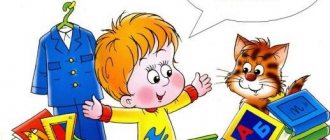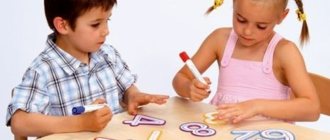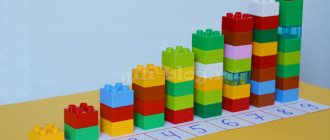Interesting articles
Summary of mathematics classes in kindergarten according to the Federal State Educational Standard
All parents want their child to be smart and successful in life. At five years old, children already know a lot and can carry on a small conversation and draw conclusions. Some children can even read at this age. Currently, there are a lot of different circles, sections and clubs for the development of preschoolers. Many parents want to prepare their child for school and send him to various preparatory courses. But don’t forget that this is a child, he wants to play and have fun. In order not to harm the baby and not to discourage him from learning, you need to understand his desires and follow them, slightly guiding him towards development and learning. If your child likes board games, he is diligent, and you have noticed an interest in chess. Then you should send him to the chess section or start studying at home. Provided that your playing skills allow you to do so. For a child of 5 years old, chess is the most appropriate time to start learning.
The benefits of chess for children
“Without chess it is impossible to imagine the full development of mental abilities and memory. The game of chess should enter into life as one of the elements of mental culture.” V.A Sukhomlinsky is a talented Soviet teacher and writer.
If your child is hyperactive and likes chess, support his desire, as it develops perseverance and discipline. If you want to develop your child's intelligence, be sure to try teaching him to play chess.
The first steps in learning should begin with close relatives; if mom and dad do not have the appropriate knowledge, this could be grandparents. After studying the pieces and basic knowledge, you can send your child to the chess section. You will not regret it because the benefits of playing chess are obvious:
- develops the thought process;
- the baby becomes diligent and attentive;
- gives an understanding of the consequences of his actions, teaches him to be responsible;
- develops logical thinking;
- teaches you to think outside the box;
- teaches you to analyze the actions of the enemy and predict his behavior.
Chess lessons at preschool educational institutions
- Preparatory stage. You can ask parents to talk about chess, how one of their relatives participated in a tournament, offer to read or watch a chess tutorial for children together, or take the child to a place where grandmasters gather. If children get an idea about chess, they can become interested in it.
- Organization of an open chess lesson. You can teach children to draw chess boards in notebooks, recognize pieces, explain what diagonal, horizontal and vertical are. Then you should tell how each figure walks, using diagrams. Rhymes, riddles and songs will help with this.
- Repetition is the mother of learning. After a lesson in the basics of chess, children will remember only part of what they heard, and to consolidate the result, they need to conduct another quest lesson. The child is asked to remember what was said, but in a way that makes it interesting. The presence of parents is welcomed, as the child can boast of his knowledge, and parental approval will consolidate the result. Chess develops not only logic, but also creativity.
Chess play
Advice! Guys and girls can act as figures themselves, because in a team everyone always has their own role: there are princesses, kings, officers and pawns. Do not label, but explain that each figure has a special meaning and plays an extremely important role.
Math lessons for children 5-6 years old, examples and tasks
Children can be taught chess from preschool age. It develops creativity, logical thinking and allows the brain to work at full strength. Comprehensive teaching of chess to children – in the family circle and in a preschool educational institution – will strengthen the child’s desire to practice and will make it possible to understand that chess broadens one’s horizons, introduces one to new friends and gives priority in the team.
Chess from 5 years and older
Your baby is almost five, and you want to start learning, then you need to know that at this age he cannot concentrate on one thing for a long time. The first lessons should be kept very short.
Get a board with chess pieces and just let your child play with them. Next, little by little introduce each figure individually.
You can tell a fairy tale or show a cartoon about chess. The Fixies have a good series about chess:
After learning the names of the pieces and their locations on the chessboard, you can play a game similar to lotto. Place the figures in an opaque bag and let the child put his hand into the bag and determine the name by touch, and then put the figure in its place on the board.
Describe the chessboard and pieces depending on the baby's preferences. If this is a boy and he likes knights, then the board is a battlefield, the pieces are two armies that need to capture the king. If he likes Star Wars, then describe everything in accordance with this plot, you can even buy chess in the form of characters from Star Wars.
The main thing is that the child has initial associations with something familiar to him and that it reminds him of some kind of fairy tale plot.
Tell us how each figure walks and perhaps come up with some story about why it walks that way, depending on the plot you choose. This way the young chess player will better remember all the pieces and how they move.
Compare the figures and build a scale of values for each figure. Which figure is more important and why.
Do not go straight to the game, consolidate your knowledge by creating different problems on the chessboard. For example, place the enemy's pawns on the board and let the kid use one piece to cut down all the pawns in the least number of moves. To study a knight, arrange the pawns in the form of a fence for the knight to jump over and reach the edge of the board. And most importantly, remember, you are teaching a child and you need to present everything in the form of a fairy-tale game, trying not to overload him or force him.
LiveInternetLiveInternet
Chess is a game that develops a child’s analytical abilities, spatial thinking and decision-making skills. Even small children easily learn to play chess, remember the rules and play with pleasure. The most difficult thing in teaching a child to play chess is getting started.
Chess is a game that requires the ability to visualize and navigate the game board. To help a little chess player better remember what a chessboard looks like, you can use various developmental exercises. For example, ask him to draw - on a white sheet of paper or with chalk on the asphalt - a fragment of a chessboard. Or put together a fragment of a chessboard from cubes of two colors. Or take a sheet of lined paper and ask your child to color the squares in a checkerboard pattern. While walking or visiting, pay attention to objects that have a “chess” pattern. Ask your child to remember where, besides the chessboard, he saw the same pattern. In all exercises, pay attention to the alternation of light and dark fields and prompt your child if he has made a mistake.
Horizontals and verticals This is what Pawn told Slava about Chess Country. On a chessboard, white and black cells always alternate. Paths formed from cells are called lines. Lines are vertical and horizontal. Place your finger on any square near the left edge of the board. Now slide your finger across all the cells from left to right - it has “walked” along a path of eight cells. This is a horizontal line.
There are only eight horizontal lines. Run your finger over each one. Look at the picture on the previous page so as not to be mistaken. The same paths lead from you towards the enemy. They are called vertical lines. There are eight verticals, as well as horizontals. Run your finger along each vertical line. There is a picture at the top of this page in case you get confused. To point to a cell, do not point your finger at it: this is impolite. In addition, when there are pieces on the board, they can be accidentally touched. You just need to say at the intersection of which vertical and horizontal lines the desired cell is located.
Each square on the chessboard has its own address so that it cannot be confused with others. The address consists of the name of the vertical and horizontal lines that intersect on this cell. The verticals are called letters of the Latin alphabet: a, b, c, d, e, f, g, h. If you play with white, then square a is to your left. The horizontal lines are designated by numbers from 1 to 8. Then, when there are pieces on the board, you will see that number 1 is on the horizontal line on which the white king and queen stand, and number 8 is on the horizontal line on which the black king and queen stand. Look at the map on the next page: the names of the cells are now visible on it. Look at which square the white king is on. This is a vertical with the letter e and a horizontal with the number 1. This means that we must say: “The king stands on square el.” — So, I need to get to square el? - Slava asked when Pawn finished telling. - Exactly. There you will find the royal palace, and in it the White King. - How do I recognize him? “I’m sure you’ll guess right away.” Of course, horizontals and verticals are the most important lines in the chess kingdom. But you need to know not only about them. There are other lines too. Do you see how cells of the same color touch at the corners? Straight chains of such cells form diagonals. Diagonals are not like other lines. In each diagonal, all cells are the same color.
Another difference is that all horizontal and vertical lines are the same length, while the diagonals are different. Run your finger along all the diagonals and count them. Which diagonals are the longest? Which ones are the shortest? The large white diagonal and the large black diagonal have eight fields each. Where they intersect is the center of the chessboard. This is a square of four cells - two white and two black. Having said goodbye to Pawn, Slava went to look for the royal palace. The boy walked for quite a long time through white and black fields, but finally reached a large building. Approaching the huge doors of the palace, Slava heard someone inside loudly indignant: “It’s a disgrace!” Where can I find the general?! Why can't anyone in the kingdom find me a general?! It's outrageous! An important battle is coming soon, and there is no one to command the army! Slava carefully opened the door and looked inside. He saw a large hall with columns. In the middle of the hall there was a pedestal on which stood a throne, like in cartoons. On the throne sat a small man wearing a robe and crown. The Pawns stood in front of him - they all behaved very quietly and every now and then they bowed respectfully so that their berets almost fell to the floor.
The man on the throne was making the same screams that Slava had heard outside. The door creaked, and everyone immediately turned and stared at Slava. The boy was embarrassed and blushed. - Who are you and what are you doing here? - asked the man on the throne. - My name is Slava, hello. And you are probably the White King? - How did you guess? “You sit on the throne and shout at everyone else.” In fairy tales this is what kings usually do. - I know who you are! — the White King immediately declared. With these words, he jumped from the throne and quickly ran up to Slava. - You are my new general! Let's go see your troops! “You were mistaken, Your Majesty,” Slava answered politely (from cartoons he remembered how to address kings). - I'm not a general at all. Only adults and wearing caps are generals. “Nonsense,” the King snapped. - It's not about the cap. And if you want, I will find a cap for you. So, will you be my general or not?
- Why do you need a general? - To command my army, of course. After all, the battle is coming - someone must fight on my side! I have soldiers, all I need is a general. - What, your soldiers don’t know how to fight themselves? - Slava was surprised. - How can they! — the King was offended. - The best! But there must be discipline in everything. They are brought up this way: they will not go anywhere without an order, so that there is no confusion. Everything needs order! “Can’t you give orders yourself?” - Slava asked then.
https://isoveti.ru/dlya-mam/znakomstvo-rebenka-s-shaxmatnoj-doskoj.html
Chamomile 2012
Strategy Basics
After studying the figures, you can move on to strategy. The main points that a young chess player should know:
- the king is the main figure and must be protected;
- seize control of most of the board;
- do not endanger your pieces, each piece must be protected;
- Before making a move, calculate all the moves the enemy can make after your move.
Each figure should have its own value, and the baby should know this:
- Pawn - 1 point;
- Horse – 3 points;
- Elephant – 3 points;
- Rook - 5 points;
- Queen - 9 points;
- The king has no price, because if he is cut down the game will end. This is the most important figure.
The child needs to be given an association, for example, this is 1 point, one candy or one ruble, or something that is important to him, and he knows it well. Or let one point be one pawn, then a knight is three pawns.
Controlling the center of the board.
The figures located in the center acquire more weight in contrast to those who stand on the edge in their original position. They have more options for attack and retreat. The best way to do this is to use knights and pawns. And pieces such as the bishop, rook and queen are suitable for control and attack from afar.
All pieces must be involved.
When most of the pieces remain in their original places, and all the actions are done by a couple of pieces, then at a key moment you may not have enough strength to deliver a decisive blow or repel it. And when a large number of pieces control the field, then victory is inevitable.
How to play with a young grandmaster
- Don't try to beat the baby. If he constantly loses, he will quickly lose interest in the game. Sometimes lose if you see that your little student makes good moves and chose the right strategy, and you can also arrange a draw;
- You cannot lose constantly or often, because after a rare defeat he will be very worried;
- Analyze each game played with your child. Encourage good moves and discuss bad ones;
- You need to play regularly and not take long breaks;
- There is no need to expect quick and serious results from your child, do not put pressure on him;
- There is no need to let the baby walk; he must be aware of the responsibility for the move he makes.











